Axolotls became a favorite aquatic pet in the 1990s and have since gained worldwide popularity, especially during the social media era. With their endearing appearances, such as a smiling face, wide black eyes, and unique regenerative abilities, it’s no wonder they are so popular! As they are naturally solitary creatures, if you have an axolotl, it is important that you select the right tank mates for a harmonious and comfortable tank environment.
In this article, you will discover 15 perfect tank mates for your axolotls, how to care for them, and learn why they’re a suitable fit.
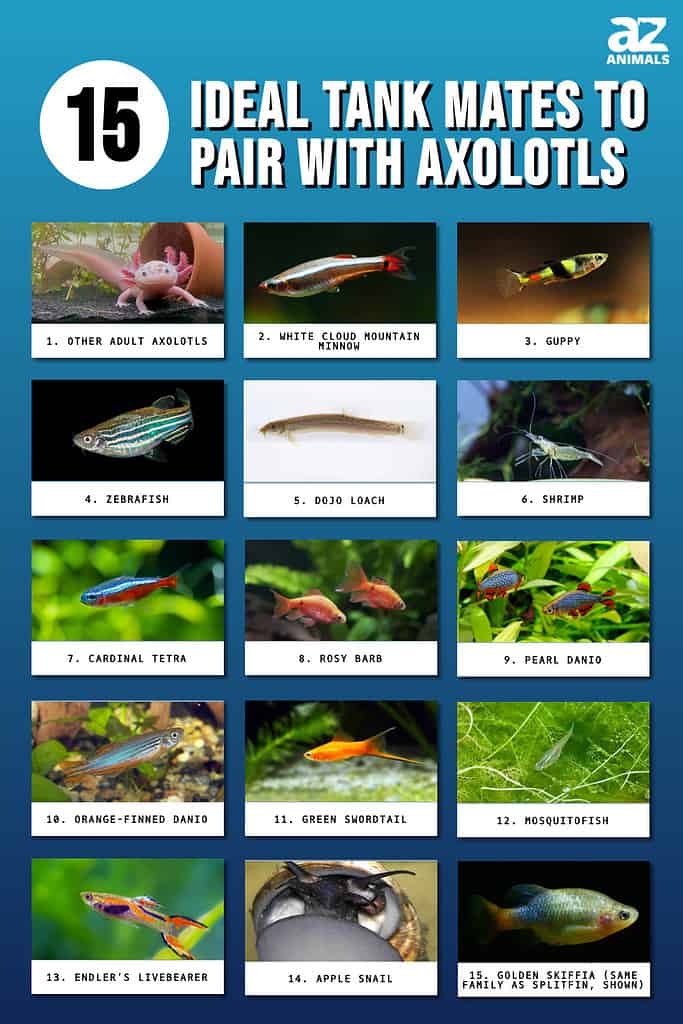
1. Other Adult Axolotls (Ambystoma mexicanum)
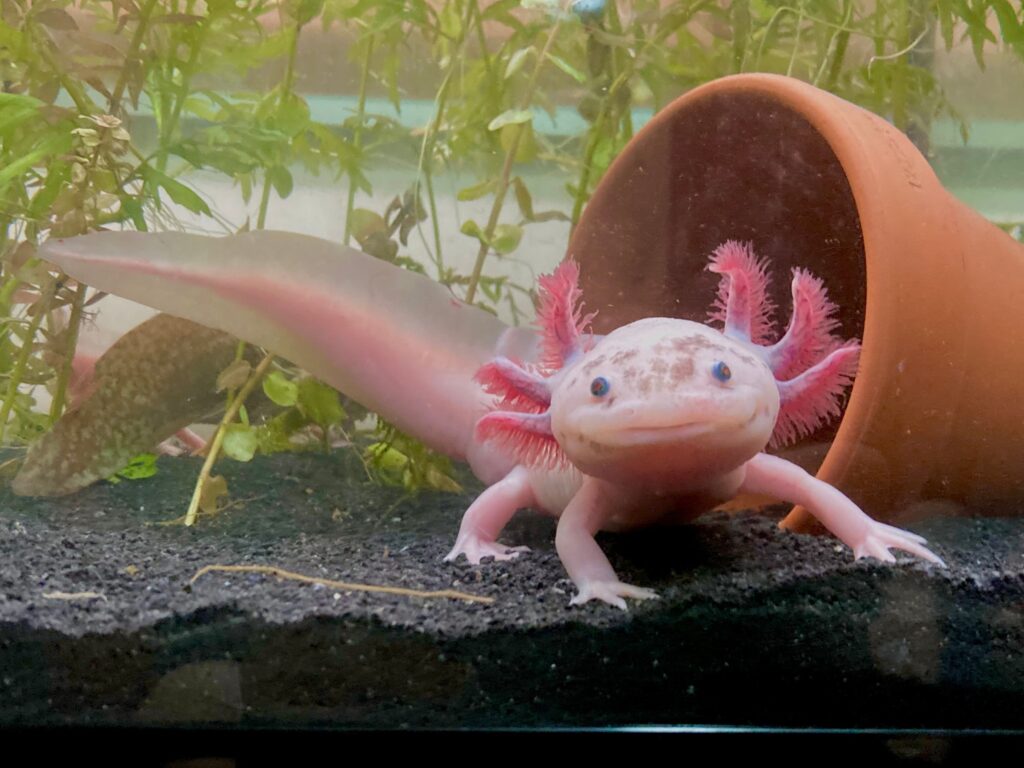
Of course, the best tank mate for an axolotl is another axolotl!
©axolotlowner/Shutterstock.com
The axolotl is native to a few lakes in Mexico. They have a lifespan of 10 to 30 years and live fully in the water. Their average size is about 9 to 12 inches in length, but some may grow up to 18 inches. These unique amphibians require spacious tanks with cool water between 60 to 68°F as warmer temperatures can stress them. If you add another axolotl to the tank, a 40-gallon tank is necessary, as each axolotl requires a 20-gallon tank. The tank should be filled with fine sand or coarse gravel, as fine gravel may obstruct the axolotl’s stomach if accidentally ingested.
Adult axolotls not only share the same diet and living conditions, but they also make perfect tank mates because they can coexist peacefully. It is also best to keep axolotls of the same gender together to prevent unwanted breeding. Additionally, keep young axolotls separate from adults, as the bigger axolotl may eat the smaller one! It is also important to provide hiding places like plants and caves to help your axolotls feel secure.
2. White Cloud Mountain Minnow (Tanichthys albonubes)
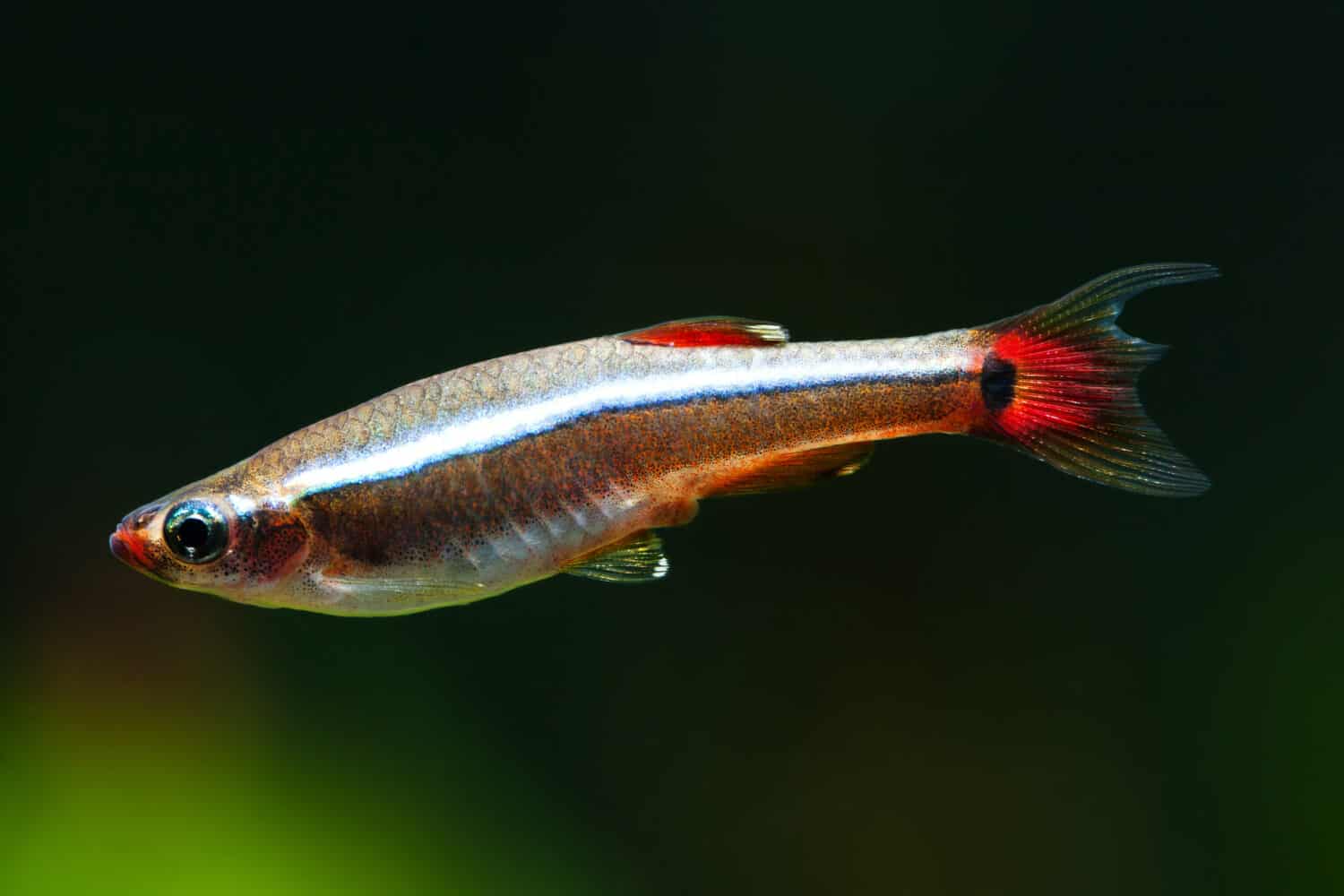
If you want to add a fish to your axolotl aquarium, try white cloud mountain minnows!
©Besjunior/Shutterstock.com
White cloud mountain minnows are small, peaceful freshwater fish native to China and Vietnam. They are popular for their beauty, easy care, and adaptability to various water conditions. These iridescent, silver fishes grow to about 1.5 to 2 inches long and should be kept in groups of 5 to 6.
One of the advantages of keeping white cloud mountain minnows with your axolotl is that they prefer cooler water temperatures like the axolotls, at around 64°F to 72°F. Moreover, adult minnows are too large for axolotls to eat, so no worries there! Furthermore, with their calm nature, the likelihood of aggressive interactions with the axolotl is minimal, thus creating a safe environment between these two species.
3. Guppy (Poecilia reticulata)

Native to South America, guppies are fast swimmers and may be able to swim away from your axolotl to avoid becoming food.
©Pavaphon Supanantananont/Shutterstock.com
The guppy fish is a suitable species for beginners as they are popular for their durability to survive various water conditions and high reproductivity. These tiny and vibrant fish are native to various regions of South America. These rainbow fishes come in various colors with vibrant, colorful tailfins and grow to an average size of up to 1.5 inches but can grow up to 2.4 inches. They require a water temperature of 72 to 82°F, similar to the axolotl. One thing to note is that since guppies breed a lot, it is advisable to keep fewer fish of the same sex to avoid overcrowding.
Guppies are ideal tank mates for axolotls because they are small and fast swimmers and are unlikely to harm the axolotl. But keep in mind that axolotls may eat your guppies if given the chance. The good news is that if this occurs, since guppies are so small, they will not cause impaction – even for younger axolotls. Guppies also occupy different water levels, utilizing top and middle areas of the tank, while axolotls stay at the bottom.
4. Zebrafish (Danio rerio)
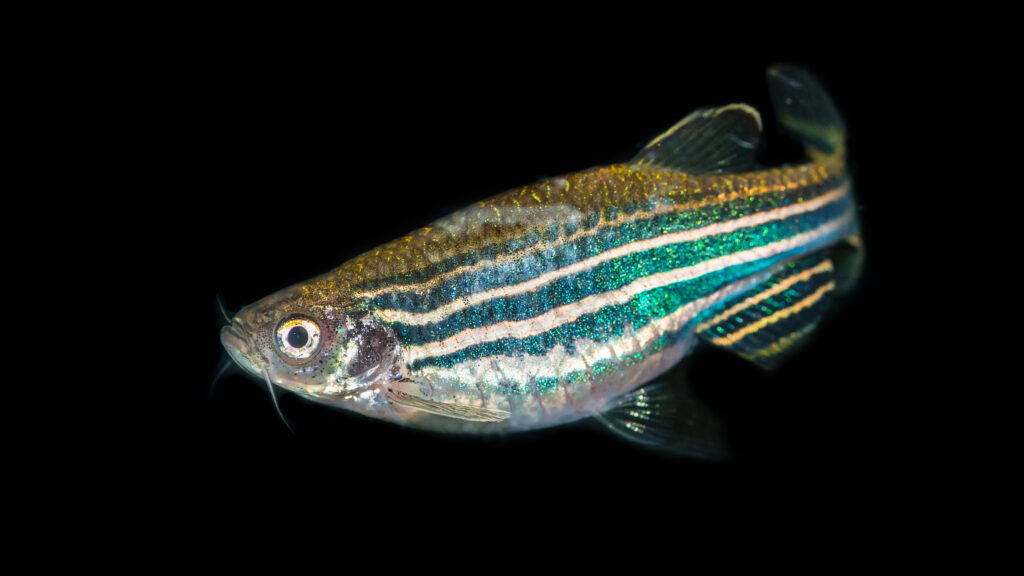
Another suitable tank mate for the axolotl is the zebrafish.
©Ian Grainger/Shutterstock.com
Zebrafish originated from several countries in South Asia, including India and Nepal. These small fish only grow up to 2 inches in length. They are popular for their striking appearance, with a distinctive zebra-like pattern with blueish-silver hues and horizontal stripes from head to tail. They require a minimum of 10 gallons for a small group of at least 6 with a water temperature of 64 to 75°F. As zebrafish are known to be active, make sure to provide hiding spots and open swimming areas for them.
Zebrafish are suitable tank mates for axolotls as they are unlikely to be perceived as food and are fast enough to swim away from the axolotls when necessary. Like the guppies, they occupy the upper and middle water levels and have similar water temperature preferences. Their peaceful nature and resilience make them an ideal fit for the aquarium.
5. Dojo Loach (Misgurnus anguillicaudatus)

Native to Asia, dojo loaches prefer cold water, are peaceful, and share a similar diet with the axolotl.
©23frogger/Shutterstock.com
Dojo loaches are native to East Asia, such as China, Korea, and Japan. Historically, Dojo loaches were popular in Chinese rice paddies, where they were valued for their ability to help control pest populations. In terms of appearance, dojo loaches have an elongated, eel-like body shape and no scales and generally exhibit shades of olive or brown. These loaches are relatively large; they can grow to an average length of 4 to 8 inches. Ideally, a tank size of a minimum of 30 gallons is required for a small group of loaches.
Like the axolotl, they are a species that prefers cold water with a temperature of 65 to 77°F. They are also peaceful and unlikely to harass or stress the axolotl, and they share a similar diet, eating food such as pellets, brine shrimp, and frozen bloodworms.
6. Shrimp (Caridea)
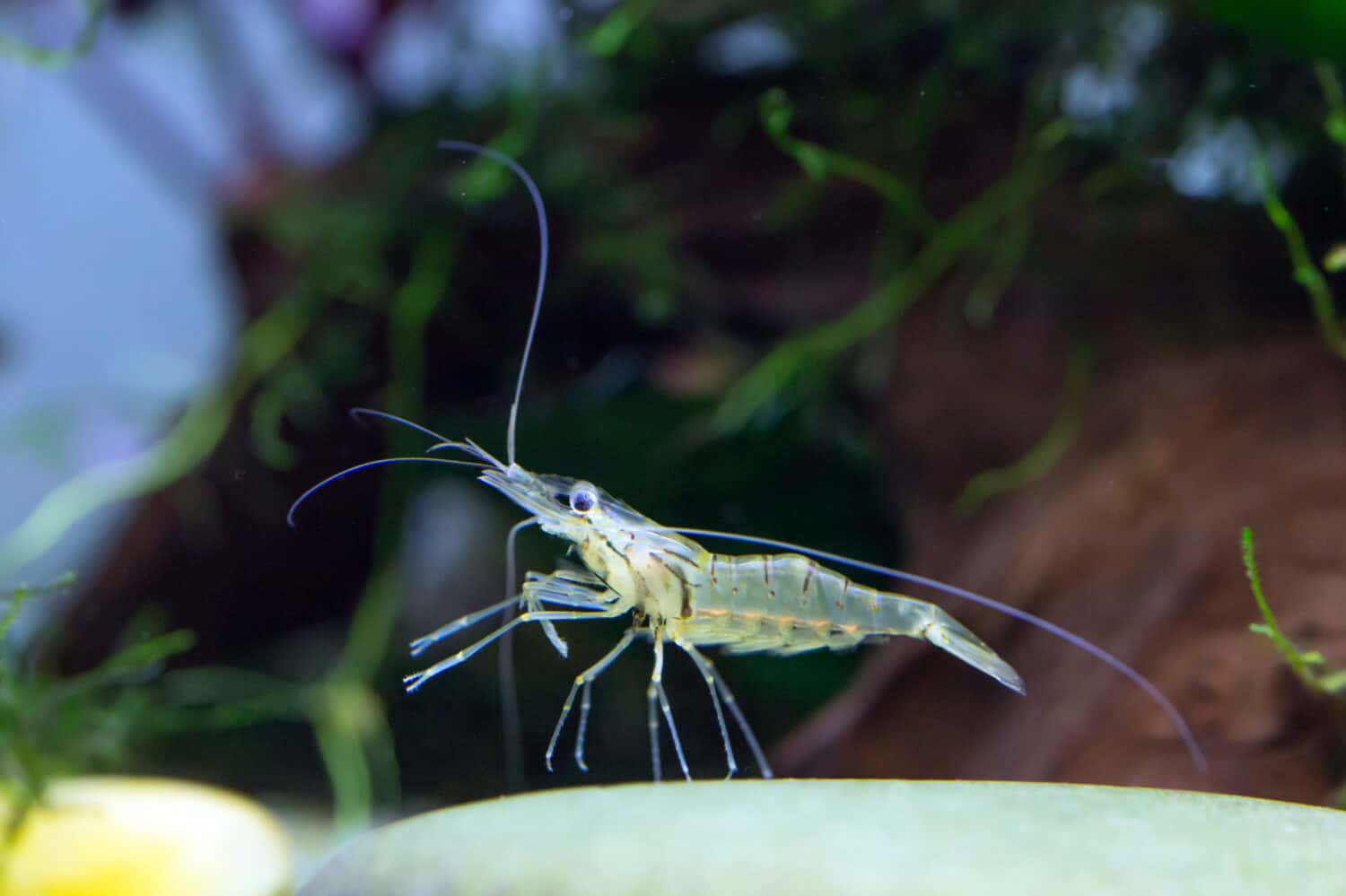
Some shrimp, like ghost shrimp, make great tank mates for axolotls.
©boban_nz/Shutterstock.com
Shrimp are an interesting choice for a tank mate for an axolotl, but they can coexist relatively well. These are crustaceans that originated from various regions around the world. They can range in size from 0.5 to 3 inches long, depending on the type, and come in various colors. The right water temperature for most common shrimp species is around 68 to 78°F.
Most types of shrimp can survive in the same water conditions and parameters as axolotls, making them ideal tank mates. Moreover, shrimp like to keep to the substrate, and they enjoy tanks with plenty of plants, just like axolotls. More importantly, shrimps tend to be very peaceful creatures and are not likely to start fights with the axolotls in your tank. However, one thing to keep in mind is that your axolotl may try to eat your shrimp, since they are both bottom feeders and scavengers. More likely than not, though, your shrimp may be aggressive when attacked, so it should be able to look after itself.
7. Cardinal Tetra (Paracheriodon axelrod)
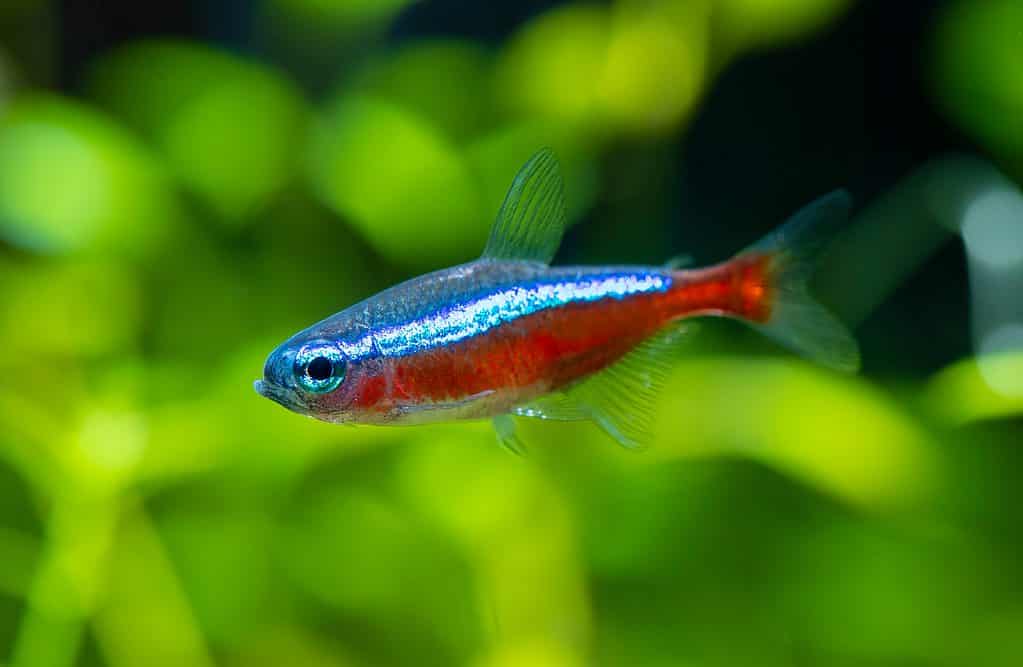
The beautiful colors of the cardinal tetra can add to your axolotl aquarium.
©NattapolStudiO/Shutterstock.com
The cardinal tetra is a freshwater fish that originated from the Amazon basin of South America. Adult cardinal tetras grow to about 1.5 inches in length. They have an elongated body with bright blue iridescent coloration along their top half and a red stripe at the lower half of their body. They thrive in water temperatures of 72 to 82°F.
Cardinal tetras are peaceful and non-aggressive, and their small size would not pose a threat to the axolotl. They also prefer to be in the upper and middle areas of the tank, so they are not likely to become food. Furthermore, as mentioned above, the tetra shares a similar temperature environment as the axolotl. And, of course, their stunning and striking colors enhance the aesthetics of the aquarium while maintaining a harmonious cohabitation between the two species.
8. Rosy Barb (Pethia conchonius)
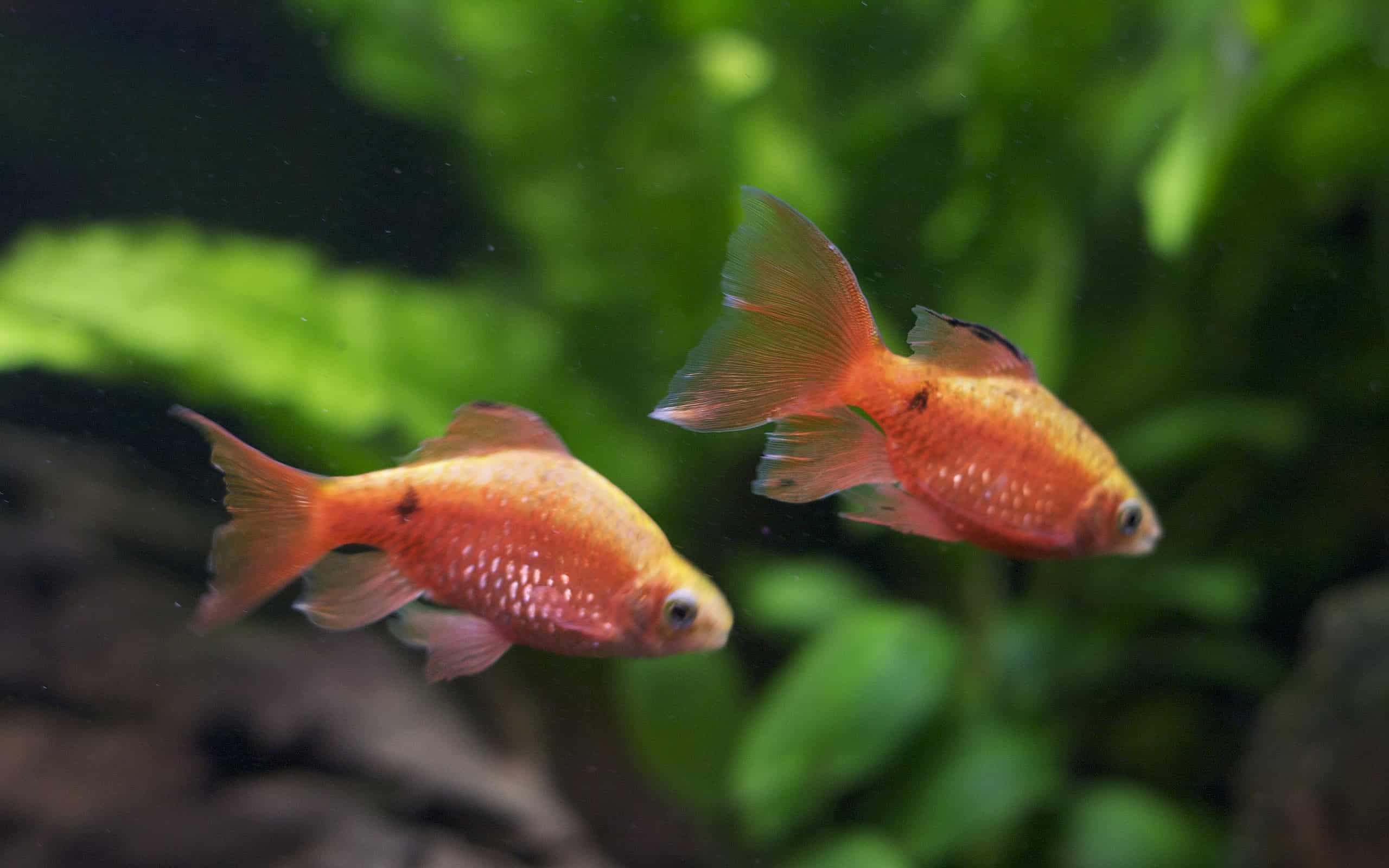
As particularly hardy fish, rosy barbs are active swimmers that have similar water temperature needs as the axolotl.
©Kkonstan, CC BY 3.0, via Wikimedia Commons – License
Rosy barbs are native to various regions in South Asia, including India and Nepal. They are hardy, easy to care for, and compatible with a variety of tank mates. Adult rosy barbs can grow to a length of around 3 to 4 inches. A minimum of 20 gallons is recommended for a small group of rosy barbs, with a water temperature of 64 to 75°F.
These active swimmers primarily occupy the middle and upper levels of the tank, and their larger size is not generally seen as prey by the axolotl – though they may still try! With a similar water temperature preference and the rosy barb’s peaceful nature, both species may cohabit easily. And as a plus, the rosy barb’s bright iridescent colors will light up your aquarium.
9. Pearl Danio (Danio albolineatus)
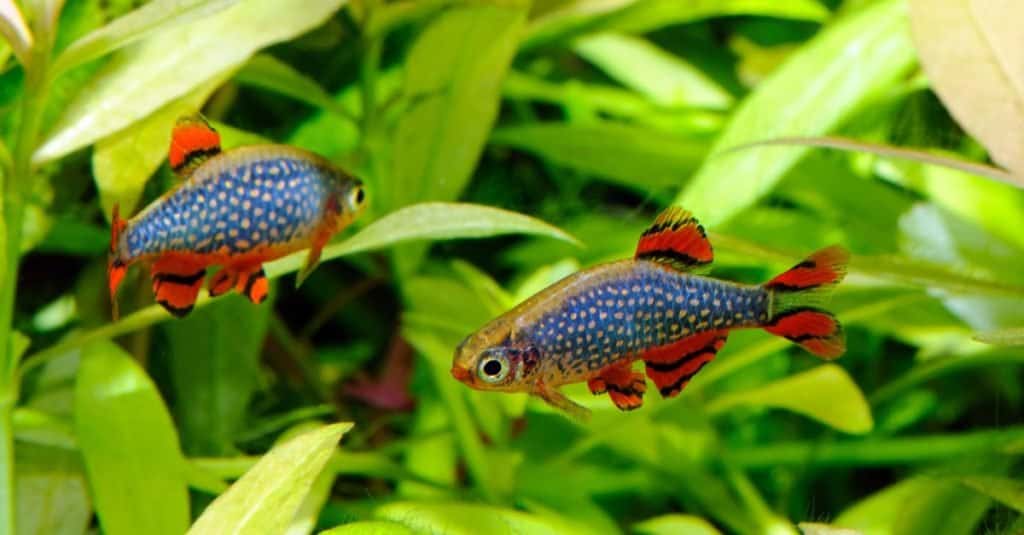
The pearl danio can tolerate a wide range of water temperatures, ranging from 64 to 72 degrees Fahrenheit.
©Bos11/Shutterstock.com
Named after its iridescent appearance, the pearl danio is one of the most attractive freshwater fish and a popular addition to home aquariums. They originated from the rivers of Myanmar and Thailand. Pearl danios are peaceful and well-suited for aquariums and get along with any peaceful fish. These fish can grow to be around 2.5 inches long. Furthermore, they are tolerant of a wide range of water conditions with a temperature of 64 to 72°F. The minimum volume is 10 gallons, with a minimum of six in a group.
Pearl danios can make good tank mates for axolotls because they are fast swimmers, and they swim in schools as protection against the axolotl when placed in the same tank. Their peaceful nature means they won’t likely bother your axolotl, making them less likely to become food.
10. Orange-Finned Danio (Brachydanio kyathit)
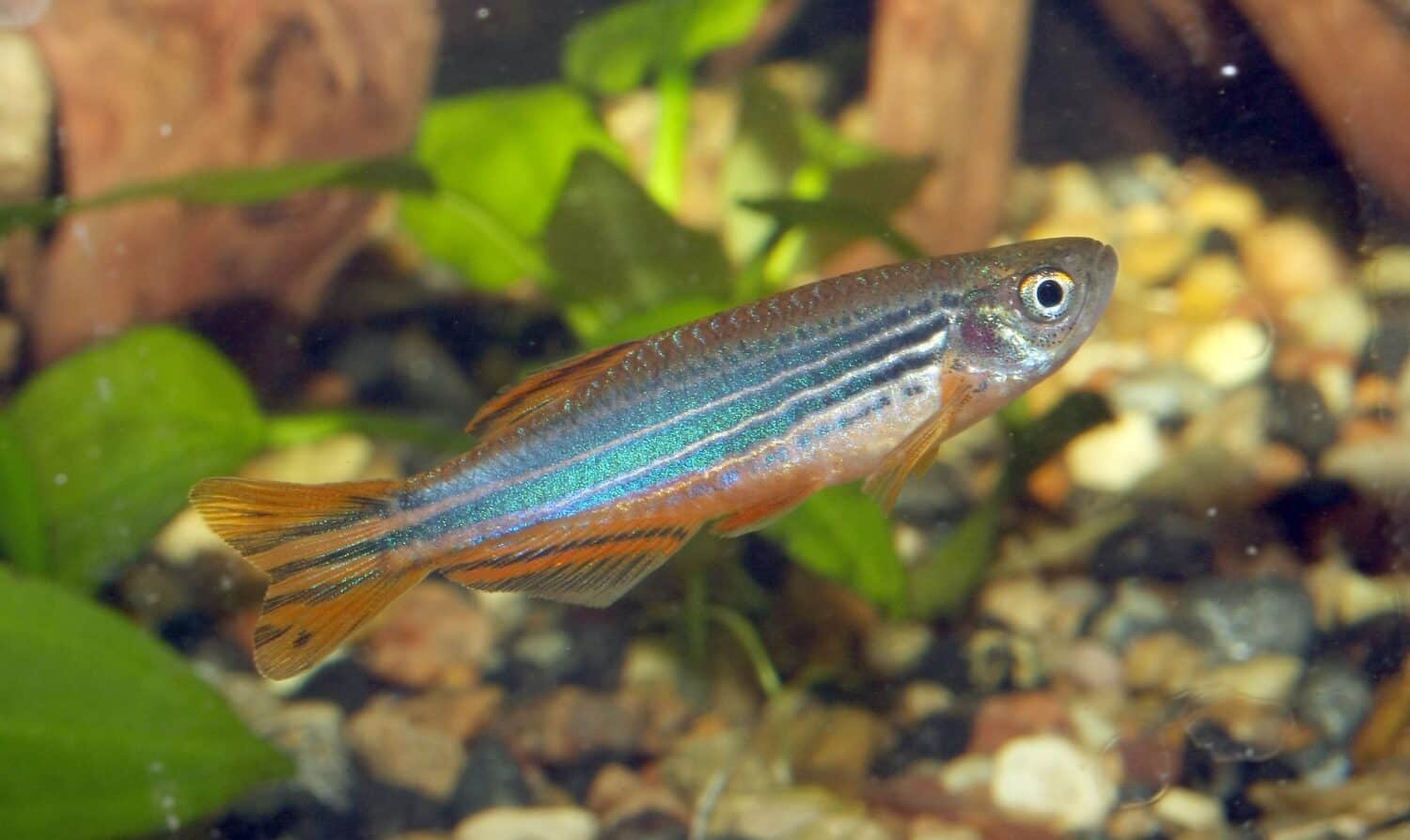
A calm addition to any aquarium, orange-finned danios are fast swimmers, making them less likely to become axolotl food.
©VladiMil/Shutterstock.com
Orange-finned danios originated from the clear streams and rivers in Myanmar. These vibrant fish are cherished for their lively nature and striking orange fins, from which they get their name. They also have a silvery-blue hue and vertical black stripes. They typically grow to an adult size of around 1.5 to 2 inches in length. A small group of 6 is ideal for these danios, with a minimum of 10 gallons of water.
Orange-finned danios are calm additions to your axolotl aquarium and are excellent for giving your aquarium a little more color. Their fast swimming abilities also make them less likely to become food to the axolotls. Additionally, the similar water preference of the danios and the axolotl, at 70 to 78°F, makes for easier tank maintenance.
11. Green Swordtail (Xiphophorus helleri)

As its name suggests, the green swordtail has a long, sword-like tail.
©topimages/Shutterstock.com
The name behind the green swordtail comes from this fish’s unique sword-like extension on its lower fins and its attractive green color. These lively fishes originated from the rivers and streams of Mexico and Central America. Adult green swordtails can grow to a size of around 3 to 6 inches in length. An absolute minimum of 15 gallons is recommended for a small group of 5 green swordtail fish, with a water temperature of 65 to 82°F.
As the green swordtails have long tails, make sure to provide multiple hiding spots and open swimming spaces for them. This is to avoid the chances of the axolotl nibbling on their tails or eating them whole. Thankfully, these swordtails are active swimmers and prefer to be at the upper and middle levels of the tank – away from the axolotl, making them good tank mates. Moreover, their peaceful nature enables your axolotl to have solitary space.
12. Mosquitofish (Gambusia affinis)
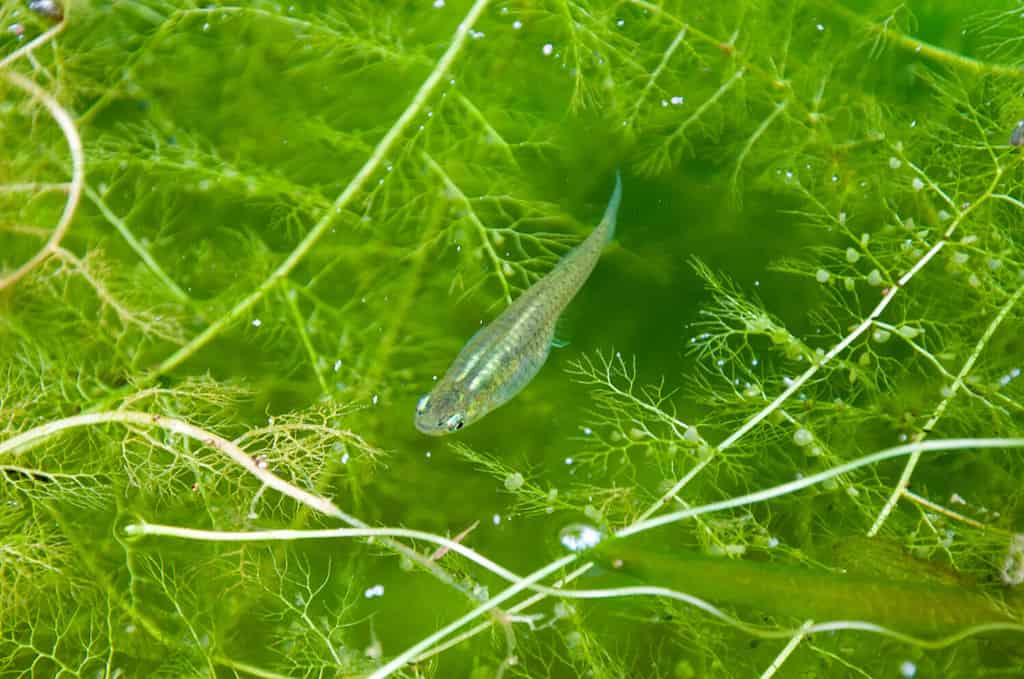
Adult mosquitofish are quite large and less likely to be eaten by the axolotl.
©Lorenzo Sala/Shutterstock.com
Originating from North and Central America, the mosquitofish have been introduced to various regions around the world to help combat mosquito populations, hence its name. The adult mosquitofish typically grows to a size of around 2 to 2.5 inches in length and has a slender body with a silvery-gray coloration. A small group of mosquitofish can thrive in a 10-gallon tank with a water temperature of 70 to 80°F.
Adult mosquitofish are relatively large, thus less likely to be perceived as food, and their ability to survive in various environments makes them suitable tank mates. Apart from acting as pest control, they can be a decent tank mate to pair with your axolotl.
13. Endler’s Livebearer (Poecilia wingei)
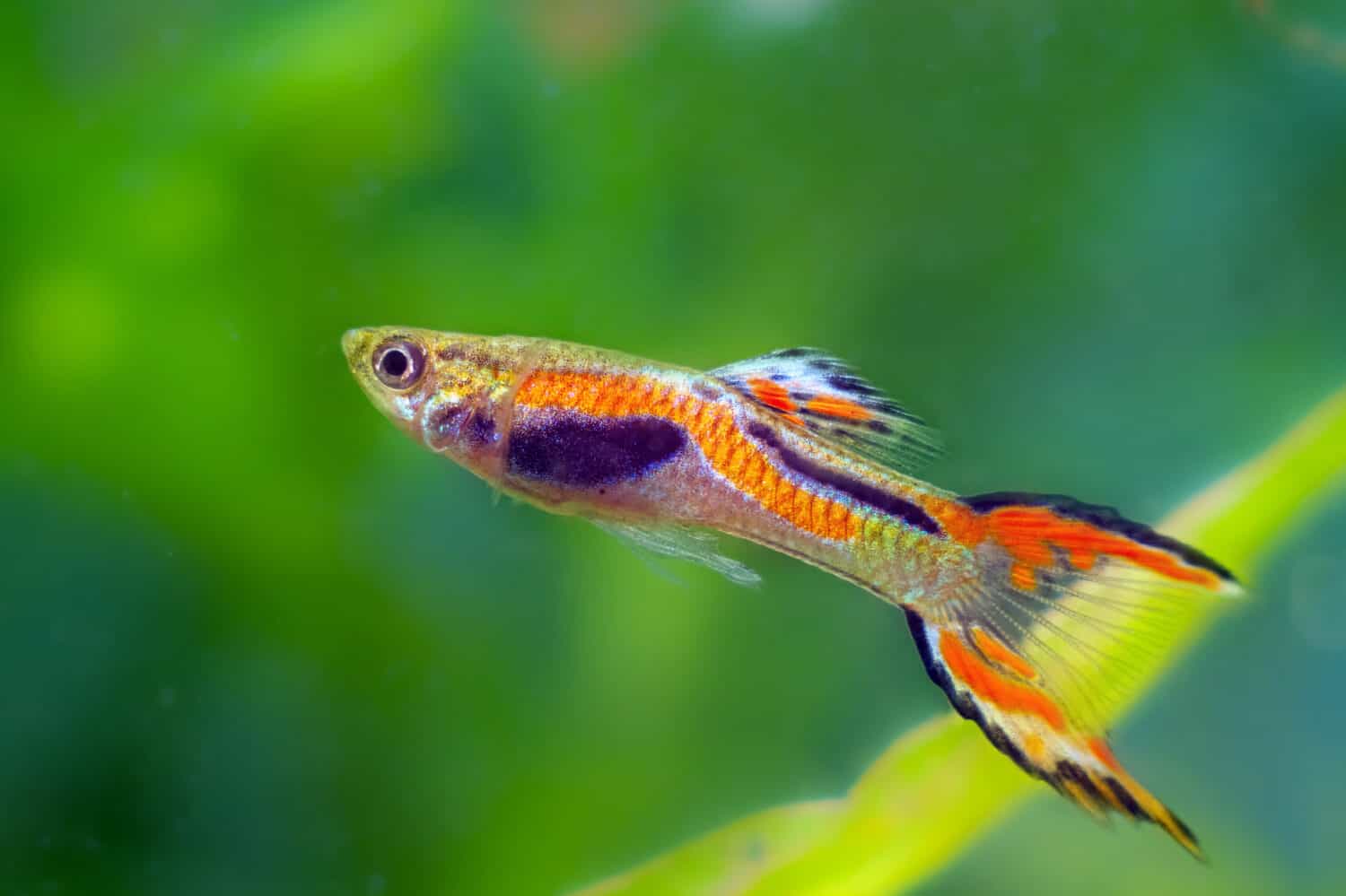
Endler’s livebearers make good tank mates for axolotls as they thrive in similar water temperatures and are peaceful in nature.
©Aleron Val/Shutterstock.com
Originating from the streams and rivers of Venezuela, Endler’s livebearers are tiny and energetic fish known for their striking appearance and active nature. They are a mix of vibrant colors and grow to around 1 to 2 inches in length. Despite their small size, these active fish can rapidly swim away from your axolotl when necessary.
A minimum of 10 gallons is recommended for a small group of Endler’s livebearers, but more space is always welcome! These fish thrive in water temperatures of 70 to 82°F, similar to the axolotl at the lower temperature range. They can be a peaceful tank mate as well.
14. Apple Snail (Ampullariidae)
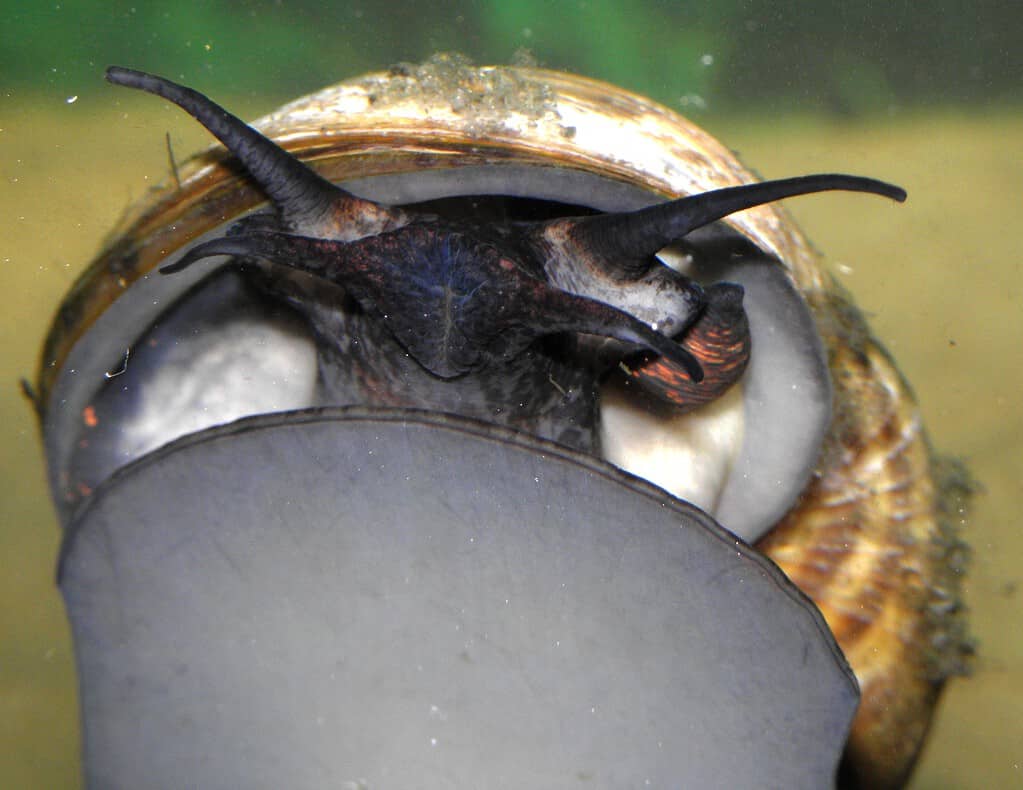
Although apple snails can make good axolotl tank mates, be careful about what size apple snail you put in the tank.
©CHUCAO / CC BY-SA 3.0 – License
The adult apple snail, native to South America, is a great tank companion for your axolotl, as it will generally be too large to be consumed. A fully grown apple snail reaches about 6 inches in diameter. A minimum of 10 gallons is suitable for a single apple snail, and it is best to keep only a couple as they proliferate quickly. They can survive in a wide range of water temperatures of 64 to 82°F, perfect for cohabitating with an axolotl.
Apple snails are generally peaceful creatures and can coexist with axolotls without causing any issues, and they keep the tank clean and balanced by consuming algae and decaying matter. Their slow-moving and non-threatening nature makes them a suitable tank mate for axolotl. However, keep in mind that it’s best to keep a larger apple snail with a younger axolotl as if an axolotl does try to eat an apple snail, it may cause issues as it may not pass.
15. Golden Skiffia (Skiffia francesae)

The golden skiffia is splitfin which is in the same family as the redtail splitfin seen here.
©Pavaphon Supanantananont/Shutterstock.com
The golden skiffia is a captivating and endangered species of freshwater fish found in Mexico. Adults of this species typically grow to a size of about 2 inches in length, making it an acceptable and harmless size for your axolotl. They require a minimum of 10 gallons for a small group with a warmer water temperature of 70 to 78°F.
Golden skiffias are a rare and interesting breed to add to your axolotl aquarium. With their striking golden coloration and unique split tail, they will add visual interest to the tank and provide stimulation for the axolotl.
Summary of 15 Ideal Tank Mates to Pair With Axolotls
| Number | Tank Mate | Scientific Name |
|---|---|---|
| 1 | Adult Axolotls | Ambystoma mexicanum |
| 2 | White Cloud Mountain Minnows | Tanichthys albonubes |
| 3 | Guppy Fish | Poecilia reticulata |
| 4 | Zebrafish | Danio rerio |
| 5 | Dojo Loaches | Misgurnus anguillicaudatus |
| 6 | Shrimp | Caridea (infraorder) |
| 7 | Cardinal Tetra | Paracheriodon axelrod |
| 8 | Rosy Barb | Pethia conchonius |
| 9 | Pearl Danio | Danio albolineatus |
| 10 | Orange-Finned Danio | Brachydanio kyathit |
| 11 | Green Swordtail | Xiphophorus helleri |
| 12 | Mosquitofish | Gambusia affinis |
| 13 | Endler’s Livebearers | Poecilia wingei |
| 14 | Apple Snail | Ampullariidae (family) |
| 15 | Golden Skiffia | Skiffia francesae |
The photo featured at the top of this post is © axolotlowner/Shutterstock.com
Thank you for reading! Have some feedback for us? Contact the AZ Animals editorial team.





